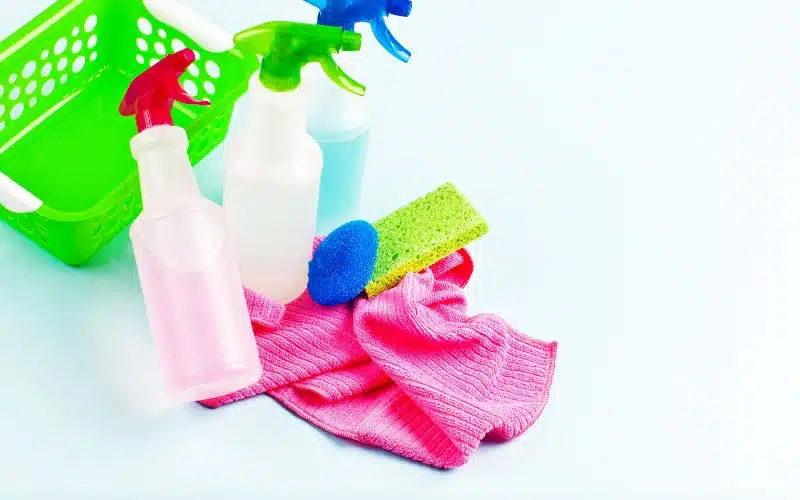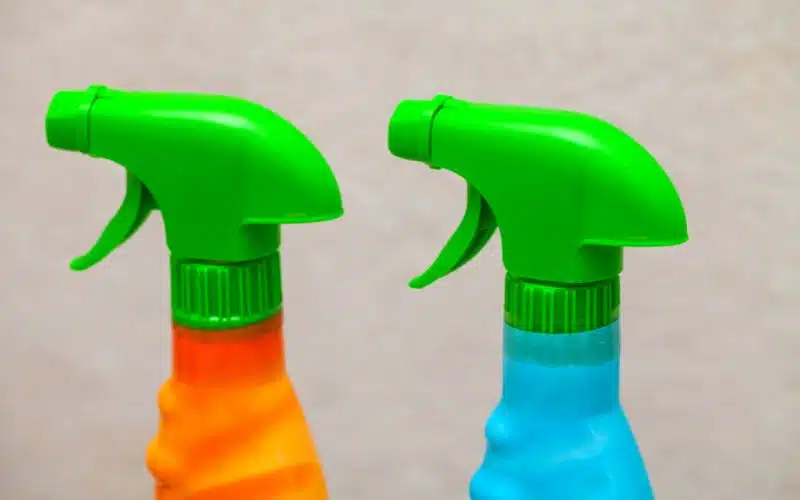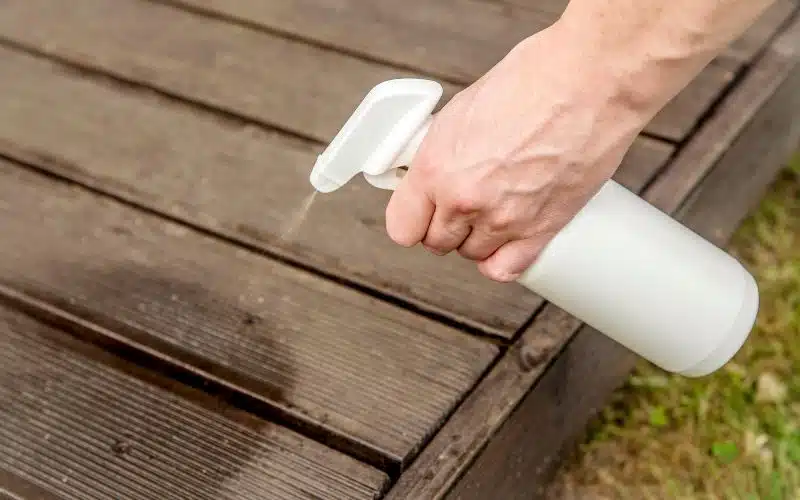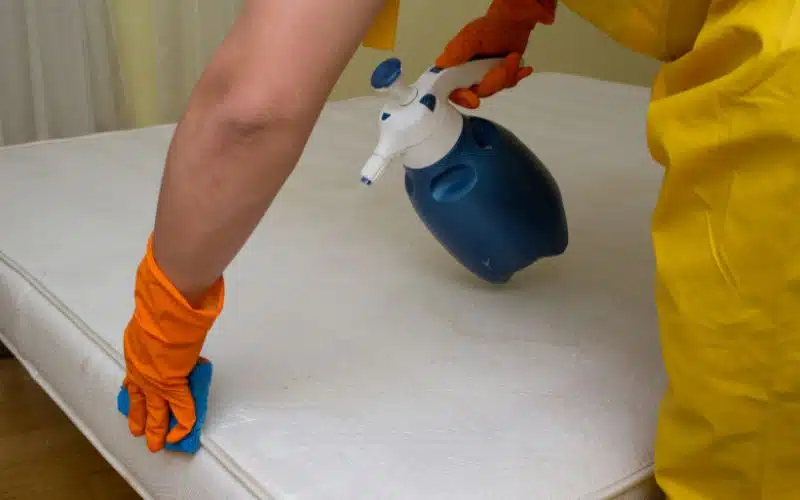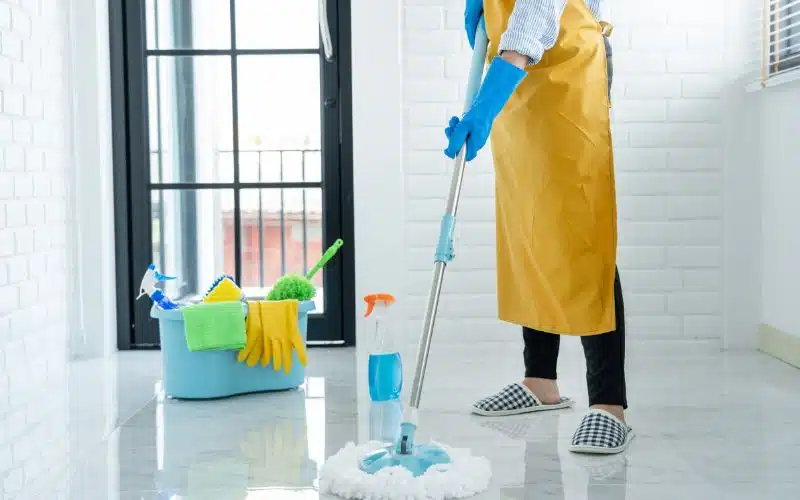Do you know we spend one-third of our lives sleeping? That is mostly in the bedroom. These bedrooms have mattresses and soft furnishings that you cannot put in a washing machine.
It gives room for unseen bacteria and dirt to breed and multiply. Lysol sanitizer kills about 99.9% of bacteria and germs found on home bedding better than regular detergents. However, can you use them on mattresses? Read on to find out.
Using Lysol appropriately, especially the milder products for fabrics and mattresses, won’t harm your skin. Lysol contains hydrogen peroxide, which easily removes germs on the surfaces of both mattresses and clothing. After using Lysol spray on a surface, you should avoid those surfaces because Lysol contains toxic substances that can irritate the skin.
Is It Safe to Spray Lysol on a Mattress?
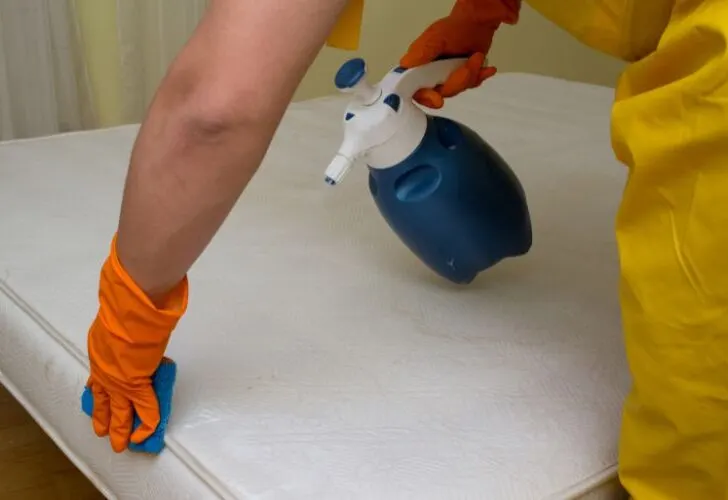
If you are wondering whether or not you can use your mattresses to disinfect, sanitize, and deodorize, you can.
However, it would help if you used it with care because improper usage can cause harm to you.
While you sleep, dead skin cells from your body, loved ones, and pets drop on your mattress when snuggling.
These form major breeding grounds for bacteria and dirt, especially when you don’t clean your mattress and bedding regularly.
Lysol helps to sanitize and get rid of those harmful bacteria that can affect your health.
However, it’s important to mention that you should use it with care, as it can cause harm if exposed to toxic amounts.
Is Lysol Safe After It Dries?
Lysol contains potentially toxic chemicals that will harm you in sufficient quantities. For this reason, it is best not to use your mattress immediately after using Lysol.
Ensure you properly wipe off the area where you spray Lysol even after the mattress dries. That is so that there are no remnants on the surface.
For more efficacy and maximum results, allow some time to pass before you wipe the area where you applied Lysol.
Use a wet cloth to wipe the area. After it dries, allow the wet surface of the area cleaned by the cloth to dry completely. That is because it evaporates immediately, leaving some remnants.
Make sure you wipe the surface of the application after it has properly dried with a wet cloth at least twice. After that, give it at least two hours to dry.
Lysol contains phenol, which can cause convulsions, burning sensations, coma, and circulatory breakdown.
Similarly, inhaling a small amount might not cause mild coughing, but constant exposure can lead to more severe health complications.
According to the Environmental Protection Agency(EPA), exposure to some of these compounds can irritate the nose and throat.
That can lead to loss of coordination, harm to the liver, kidneys, and central nervous system, and cancer with chronic exposure.
Improper use of Lysol can affect your health negatively. Use warm water and antibacterial soap to wash your hands to avoid skin irritation regularly.
Do You Wipe Lysol Off After Spraying?
It’s best to wipe Lysol off after spraying. After spraying the surface with Lysol, please leave it to dry for about 10 minutes.
After that, wipe off the sprayed area with a clean cloth. All Lysol cleaners require wiping after spraying.
Nonetheless, you shouldn’t clean them in the same manner. You should also clean the surface before disinfecting; else, it won’t effectively remove the dust and dirt on the surface.
After cleaning, spray a cleaner on the surface and let it sit for at least 10 minutes before wiping. If you wipe it before ten minutes are up, the surface won’t disinfect thoroughly.
Is Lysol Disinfectant Spray Toxic?
Lysol disinfectant spray is toxic because most of its ingredients are lethal. It contains bleach, hydrogen peroxide, ethanol, ammonium chloride, and many others.
Their toxicity to the human body has respiratory impacts such as asthma and irritation, which are corrosive to the lungs.
These chemicals can cause nausea, burning, irritation, choking, skin itching or blistering, vomiting, diarrhea, worsening sickness, and even death.
As a result, you should not apply it to the body as the manufacturer intends it for surfaces only. Inhaling it is not advisable either.
Some of Lysol’s ingredients are irritants, others are allergens, and others are toxic to humans. The skin can absorb some of the products’ chemicals.
It can inflict skin reactions when exposed continuously because of the porous nature of the skin.
Dried Lysol disinfectant is less likely to affect the skin. Likewise, it can lead to burning sensations and inflammation. The manufacturer recommends waiting for it to dry up fully before use.
Additionally, if your skin touches a mattress that you spray excessively with Lysol, the aftermath is severe. That is because of exposure to harmful chemicals.
Abiding by safety, the manufacturer’s instructions will keep you from harm. The active ingredients potentially harmful to the skin are inactive when dried.
Furthermore, over-spraying a mattress might lead to similar outcomes as a wet, freshly sprayed mattress.
Inhaling Lysol can also cause harmful repercussions depending on the amount you inhale and the chemical component.
Disinfectants like Lysol have volatile organic compounds that evaporate quickly, which you can inhale into the body. The chemicals can cause eye irritations as well.
Can Lysol Spray Be Used on Fabric?
You can use Lysol spray on fabrics, but there are some important considerations before applying it to your garments.
If you use it improperly, it can damage certain fabrics’ fibers, which will make them rigid and stiff.
It can also destroy some of the fabric dyes. For this reason, spraying Lysol products directly on fabrics can significantly weaken these materials.
It might destroy special fabrics by ruining the colors in colored garments. You can avoid this by testing a small part of the garment before spraying over the entire part of your clothing.
You can apply Lysol spray to several fabrics, including:
- Wool
- Silk
- Cotton and many other materials are available.
It’s important to note that Lysol disinfectant spray may fade delicate bed clothes, altering their color or giving them an awful smell.
If you sleep on such a mattress, you can transfer the smell to your body. The best way to avert this is by testing the product on a small area of your mattress.
Wait for at least an hour before use. If you don’t notice any damage, you can spray the rest of the mattress.
The quantity of Lysol spray you use on your mattress can also determine if it leaves residues on your mattress. For this reason, you should use a small quantity and spray it lightly on the fabric.
When Lysol leaves a stain on your mattress, it is advisable to follow up with a spot remover. Use either a paper towel or cloth to soak up enough of the excess wetness.
Lysol kills approximately 99.9% of germs on mattresses. It is best to remove any particles with a hand vacuum. Make sure you follow up with the instructions the manufacturers provide.
How to Use Lysol Spray on Fabric?
You can use Lysol spray on your fabrics if you do that properly.
- Shake properly before each use. Here are some tips to follow:
- Hold the Lysol spray about six inches away from the fabric you intend to clean.
- Make sure you spray the fabric evenly.
- Allow the material to dry up completely before you use it.
- Make sure you dispose of the can properly once it is empty.
#1. Shake Before Each Use
Shaking the can thoroughly before the application is the first thing to do. It evenly mixes the ingredients making it work when used on surfaces.
#2. Hold Lysol Can Properly
The proper way of holding the can is six inches away from the fabric you intend to clean. Please make sure you spray it evenly.
Spray an even amount over a section at a time. Doing this enables the product to distribute evenly. That prevents the occurrence of fabric damage.
#3. Allow the Product to Dry Up Before Use
When you spray the Lysol product on the area, you have to ensure that the area dries before you use or store it. It is a safety hazard to use a wet, freshly sprayed surface.
Advantages of Using Lysol Spray
The advantages of using Lysol spray include:
- Spraying Lysol on your mattress helps to disinfect your mattress.
- It helps remove offensive odors from the mattress.
- The mattress dries faster.
- Lysol spray does not leave residue on your mattress.
Disadvantages of Using Lysol Spray
The cons of using Lysol spray include:
- Inhaling Lysol in the right amount is potentially toxic to your health.
- Lysol does not remove stains from your mattress.
- There are safer options.
Conclusion
The Environmental Protection Agency (EPA) has certified Lysol because of its efficacy in eradicating germs like bacteria and viruses. However, Lysol spray is potentially harmful if you don’t use it properly.
Therefore, remember to adhere to crucial safety recommendations stated on the product label before usage. That will help you when you want to clean your mattress and avoid danger in the process.
